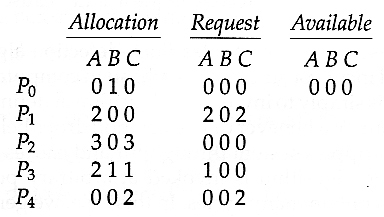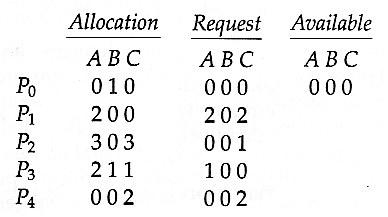Deadlock Detection, Prevention
7.3 Methods for Handling Deadlocks
- Generally speaking there are three ways of handling deadlocks:
- Deadlock prevention or avoidance - Do not allow the system to get into a deadlocked state.
- Deadlock detection and recovery - Abort a process or preempt some resources when deadlocks are detected.
- Ignore the problem all together - If deadlocks only occur once a year or so, it may be better to simply let them happen and reboot as necessary than to incur the constant overhead and system performance penalties associated with deadlock prevention or detection. This is the approach that both Windows and UNIX take.
- In order to avoid deadlocks, the system must have additional information about all processes. In particular, the system must know what resources a process will or may request in the future. ( Ranging from a simple worst-case maximum to a complete resource request and release plan for each process, depending on the particular algorithm. )
- Deadlock detection is fairly straightforward, but deadlock recovery requires either aborting processes or preempting resources, neither of which is an attractive alternative.
- If deadlocks are neither prevented nor detected, then when a deadlock occurs the system will gradually slow down, as more and more processes become stuck waiting for resources currently held by the deadlock and by other waiting processes. Unfortunately this slowdown can be indistinguishable from a general system slowdown when a real-time process has heavy computing needs.
7.4 Deadlock Prevention
- Deadlocks can be prevented by preventing at least one of the four required conditions:
7.4.1 Mutual Exclusion
- Shared resources such as read-only files do not lead to deadlocks.
- Unfortunately some resources, such as printers and tape drives, require exclusive access by a single process.
7.4.2 Hold and Wait
- To prevent this condition processes must be prevented from holding one or more resources while simultaneously waiting for one or more others. There are several possibilities for this:
- Require that all processes request all resources at one time. This can be wasteful of system resources if a process needs one resource early in its execution and doesn't need some other resource until much later.
- Require that processes holding resources must release them before requesting new resources, and then re-acquire the released resources along with the new ones in a single new request. This can be a problem if a process has partially completed an operation using a resource and then fails to get it re-allocated after releasing it.
- Either of the methods described above can lead to starvation if a process requires one or more popular resources.
7.4.3 No Preemption
- Preemption of process resource allocations can prevent this condition of deadlocks, when it is possible.
- One approach is that if a process is forced to wait when requesting a new resource, then all other resources previously held by this process are implicitly released, ( preempted ), forcing this process to re-acquire the old resources along with the new resources in a single request, similar to the previous discussion.
- Another approach is that when a resource is requested and not available, then the system looks to see what other processes currently have those resources and are themselves blocked waiting for some other resource. If such a process is found, then some of their resources may get preempted and added to the list of resources for which the process is waiting.
- Either of these approaches may be applicable for resources whose states are easily saved and restored, such as registers and memory, but are generally not applicable to other devices such as printers and tape drives.
7.4.4 Circular Wait
- One way to avoid circular wait is to number all resources, and to require that processes request resources only in strictly increasing ( or decreasing ) order.
- In other words, in order to request resource Rj, a process must first release all Ri such that i >= j.
- One big challenge in this scheme is determining the relative ordering of the different resources
7.6 Deadlock Detection
- If deadlocks are not avoided, then another approach is to detect when they have occurred and recover somehow.
- In addition to the performance hit of constantly checking for deadlocks, a policy / algorithm must be in place for recovering from deadlocks, and there is potential for lost work when processes must be aborted or have their resources preempted.
7.6.1 Single Instance of Each Resource Type
- If each resource category has a single instance, then we can use a variation of the resource-allocation graph known as a wait-for graph.
- A wait-for graph can be constructed from a resource-allocation graph by eliminating the resources and collapsing the associated edges, as shown in the figure below.
- An arc from Pi to Pj in a wait-for graph indicates that process Pi is waiting for a resource that process Pj is currently holding.
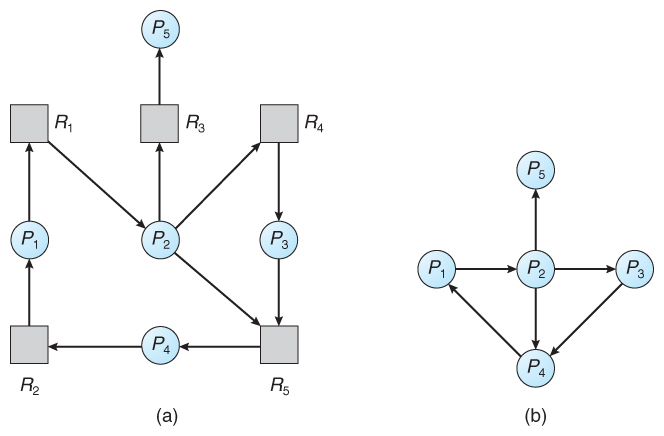 Figure 7.9 - (a) Resource allocation graph. (b) Corresponding wait-for graph
Figure 7.9 - (a) Resource allocation graph. (b) Corresponding wait-for graph
- As before, cycles in the wait-for graph indicate deadlocks.
- This algorithm must maintain the wait-for graph, and periodically search it for cycles.
7.6.2 Several Instances of a Resource Type
- The detection algorithm outlined here is essentially the same as the Banker's algorithm, with two subtle differences:
- In step 1, the Banker's Algorithm sets Finish[ i ] to false for all i. The algorithm presented here sets Finish[ i ] to false only if Allocation[ i ] is not zero. If the currently allocated resources for this process are zero, the algorithm sets Finish[ i ] to true. This is essentially assuming that IF all of the other processes can finish, then this process can finish also. Furthermore, this algorithm is specifically looking for which processes are involved in a deadlock situation, and a process that does not have any resources allocated cannot be involved in a deadlock, and so can be removed from any further consideration.
- Steps 2 and 3 are unchanged
- In step 4, the basic Banker's Algorithm says that if Finish[ i ] == true for all i, that there is no deadlock. This algorithm is more specific, by stating that if Finish[ i ] == false for any process Pi, then that process is specifically involved in the deadlock which has been detected.
- ( Note: An alternative method was presented above, in which Finish held integers instead of booleans. This vector would be initialized to all zeros, and then filled with increasing integers as processes are detected which can finish. If any processes are left at zero when the algorithm completes, then there is a deadlock, and if not, then the integers in finish describe a safe sequence. To modify this algorithm to match this section of the text, processes with allocation = zero could be filled in with N, N - 1, N - 2, etc. in step 1, and any processes left with Finish = 0 in step 4 are the deadlocked processes. )
- Consider, for example, the following state, and determine if it is currently deadlocked:
- Now suppose that process P2 makes a request for an additional instance of type C, yielding the state shown below. Is the system now deadlocked?
7.6.3 Detection-Algorithm Usage
- When should the deadlock detection be done? Frequently, or infrequently?
- The answer may depend on how frequently deadlocks are expected to occur, as well as the possible consequences of not catching them immediately. ( If deadlocks are not removed immediately when they occur, then more and more processes can "back up" behind the deadlock, making the eventual task of unblocking the system more difficult and possibly damaging to more processes. )
- There are two obvious approaches, each with trade-offs:
- Do deadlock detection after every resource allocation which cannot be immediately granted. This has the advantage of detecting the deadlock right away, while the minimum number of processes are involved in the deadlock. ( One might consider that the process whose request triggered the deadlock condition is the "cause" of the deadlock, but realistically all of the processes in the cycle are equally responsible for the resulting deadlock. ) The down side of this approach is the extensive overhead and performance hit caused by checking for deadlocks so frequently.
- Do deadlock detection only when there is some clue that a deadlock may have occurred, such as when CPU utilization reduces to 40% or some other magic number. The advantage is that deadlock detection is done much less frequently, but the down side is that it becomes impossible to detect the processes involved in the original deadlock, and so deadlock recovery can be more complicated and damaging to more processes.
- ( As I write this, a third alternative comes to mind: Keep a historical log of resource allocations, since that last known time of no deadlocks. Do deadlock checks periodically ( once an hour or when CPU usage is low?), and then use the historical log to trace through and determine when the deadlock occurred and what processes caused the initial deadlock. Unfortunately I'm not certain that breaking the original deadlock would then free up the resulting log jam. )
7.5 Deadlock Avoidance
- The general idea behind deadlock avoidance is to prevent deadlocks from ever happening, by preventing at least one of the aforementioned conditions.
- This requires more information about each process, AND tends to lead to low device utilization. ( I.e. it is a conservative approach. )
- In some algorithms the scheduler only needs to know the maximum number of each resource that a process might potentially use. In more complex algorithms the scheduler can also take advantage of the schedule of exactly what resources may be needed in what order.
- When a scheduler sees that starting a process or granting resource requests may lead to future deadlocks, then that process is just not started or the request is not granted.
- A resource allocation state is defined by the number of available and allocated resources, and the maximum requirements of all processes in the system.
7.5.1 Safe State
- A state is safe if the system can allocate all resources requested by all processes ( up to their stated maximums ) without entering a deadlock state.
- More formally, a state is safe if there exists a safe sequence of processes { P0, P1, P2, ..., PN } such that all of the resource requests for Pi can be granted using the resources currently allocated to Pi and all processes Pj where j < i. ( I.e. if all the processes prior to Pi finish and free up their resources, then Pi will be able to finish also, using the resources that they have freed up. )
- If a safe sequence does not exist, then the system is in an unsafe state, which MAY lead to deadlock. ( All safe states are deadlock free, but not all unsafe states lead to deadlocks. )
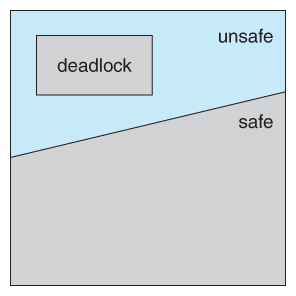 Figure 7.6 - Safe, unsafe, and deadlocked state spaces.
Figure 7.6 - Safe, unsafe, and deadlocked state spaces.
- For example, consider a system with 12 tape drives, allocated as follows. Is this a safe state? What is the safe sequence?
| Maximum Needs | Current Allocation |
|---|
| P0 |
10
|
5
|
|---|
| P1 |
4
|
2
|
|---|
| P2 |
9
|
2
|
|---|
- What happens to the above table if process P2 requests and is granted one more tape drive?
- Key to the safe state approach is that when a request is made for resources, the request is granted only if the resulting allocation state is a safe one.
7.5.2 Resource-Allocation Graph Algorithm
- If resource categories have only single instances of their resources, then deadlock states can be detected by cycles in the resource-allocation graphs.
- In this case, unsafe states can be recognized and avoided by augmenting the resource-allocation graph with claim edges, noted by dashed lines, which point from a process to a resource that it may request in the future.
- In order for this technique to work, all claim edges must be added to the graph for any particular process before that process is allowed to request any resources. ( Alternatively, processes may only make requests for resources for which they have already established claim edges, and claim edges cannot be added to any process that is currently holding resources. )
- When a process makes a request, the claim edge Pi->Rj is converted to a request edge. Similarly when a resource is released, the assignment reverts back to a claim edge.
- This approach works by denying requests that would produce cycles in the resource-allocation graph, taking claim edges into effect.
- Consider for example what happens when process P2 requests resource R2:
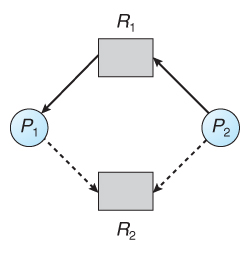 Figure 7.7 - Resource allocation graph for deadlock avoidance
Figure 7.7 - Resource allocation graph for deadlock avoidance
- The resulting resource-allocation graph would have a cycle in it, and so the request cannot be granted.
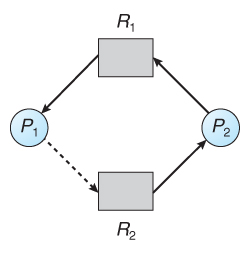 Figure 7.8 - An unsafe state in a resource allocation graph
Figure 7.8 - An unsafe state in a resource allocation graph

